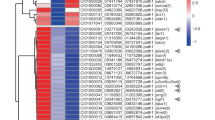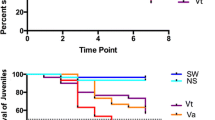Abstract
Injection of shrimp with non-specific double-stranded RNA (dsRNA) of diverse lengths, sequences, and base compositions is known to induce non-specific immunity and protect against lethal disease, although the mechanisms are unclear. Previous shrimp studies examined the effects of non-specific RNA on particular pathways, while their global effects have not been examined. To understand the global effects of non-specific RNA in shrimp, we injected kuruma shrimp (Marsupenaeus japonicus) with a dsRNA and a small interfering RNA (siRNA) that is not specific to any gene in the shrimp genome and then examined global gene expression at 24 and 48 h with a microarray. For the non-specific RNA, we chose double-stranded green fluorescent protein (dsGFP) and siGFP because they are commonly used as mock controls and their effects on shrimp have not yet been studied. Injection of PBS was used as a control. The microarray results showed that many genes were up-regulated and some were down-regulated by dsGFP. In addition, dsGFP injection increased survival following WSSV challenge. The changes in expression for several genes were confirmed by quantitative PCR. The up-regulated genes included genes for eight immune-related proteins: c-type lectin 2, hemocyte homeostasis-associated protein, viral responsive protein, fibrinogen-related protein 1, sid-1 like protein, argonaute 2, Dicer 2, and heat shock protein 90. These results show that injection of shrimp with non-specific dsRNA hinders viral accumulation and prevents significant mortalities.




Similar content being viewed by others
References
Calduch-Giner JA, Echasseriau Y, Crespo D, Baron D, Planas JV, Prunet P, Pérez-Sánchez J (2014) Transcriptional assessment by microarray analysis and large-scale meta-analysis of the metabolic capacity of cardiac and skeletal muscle tissues to cope with reduced nutrient availability in gilthead sea bream (Sparus aurata L.). Mar Biotechnol 16(4):423–435
Chen YH, Jia XT, Zhao L, Li CZ, Zhang SA, Chen YG, Weng SP, He JG (2011) Identification and functional characterization of Dicer2 and five single VWC domain proteins of Litopenaeus vannamei. Dev Comp Immunol 35:661–671
Chendrimada TP, Finn KJ, Ji X, Baillat D, Gregory RI, Liebhaber SA (2007) MicroRNA silencing through RISC recruitment of eIF6. Nature 447:823–828
Conesa A, Götz S, Garcia-Gomez JM, Terol J, Talon M, Robles M (2005) Blast2GO: a universal tool for annotation, visualization and analysis in functional genomics research. Bioinformatics 21:3674–3676
Costa F, Valença N, Silva A, Bezerra G, Cavada B, Rádis-Baptista G (2011) Cloning and molecular modeling of Litopenaeus vannamei (Penaeidae) C-type lectin homologs with mutated mannose binding domain-2. Genet Mol Res 10:650–664
Daniels SM, Melendez-Pena CE, Scarborough RJ, Daher A, Christensen HS et al (2009) Characterization of the TRBP domain required for dicer interaction and function in RNA interference. BMC Mol Biol 10:38
Danwattananusorn T, Fagutao FF, Shitara A, Kondo H, Aoki T, Nozaki R, Hirono I (2011) Molecular characterization and expression analysis of heat shock proteins 40, 70 and 90 from kuruma shrimp Marsupenaeus japonicus. Fish Sci 77:929–937
De Hoon MJL, Imoto S, Nolan J, Miyano S (2004) Open source clustering software. Bioinformatics 20(9):1453–1454
Fagutao FF, Koyama T, Kaizu A, Saito-Taki T, Kondo H, Aoki T, Hirono I (2009) Increased bacterial load in shrimp hemolymph in the absence of prophenoloxidase. FEBS J 276:5298–5306
Fagutao FF, Maningas MB, Kondo H, Aoki T, Hirono I (2012) Transglutaminase regulates immune-related genes in shrimp. Fish Shellfish Immunol 32:711–715
Fagutao FF, Yasuike M, Caipang CM, Kondo H, Hirono I, Takahashi Y (2008) Gene expression profile of hemocytes of kuruma shrimp, Marsupenaeus japonicus, following peptidoglycan stimulation. Mar Biotechnol 10:731–740
Flegel TW, Sritunyalucksana K (2011) Shrimp molecular responses to viral pathogens. Mar Biotechnol 13:587–607
Galiana-Arnoux D, Dostert C, Schneemann A, Hoffmann JA, Imler JL (2006) Essential function in vivo for Dicer-2 in host defense against RNA viruses in drosophila. Nature Immunol 7:590–597
Homvises T, Tassanakajon A, Somboonwiwat K (2010) Penaeus monodon SERPIN, PmSERPIN6, is implicated in the shrimp innate immunity. Fish Shellfish Immunol 29(5):890–898
Kaitetzidou E, Crespo D, Vraskou Y, Antonopoulou E, Planas JV (2012) Transcriptomic response of skeletal muscle to lipopolysaccharide in the gilthead seabream (Sparus aurata). Mar Biotechnol 14(5):605–619
Kim DH, Behlke MA, Rose SD, Chang MS, Choi S, Rossi JJ (2005) Synthetic dsRNA Dicer substrates enhance RNAi potency and efficacy. Nat Biotechnol 23:222–226
Labreuche Y, Veloso A, de la Vega E, Gross PS, Chapman RW, Browdy CL (2010) Non-specific activation of antiviral immunity and induction of RNA interference may engage the same pathway in the Pacific white leg shrimp Litopenaeus vannamei. Dev Comp Immunol 34:1209–1218
Li F, Wang D, Li S (2010) A Dorsal homolog (FcDorsal) in the Chinese shrimp Fenneropenaeus chinensis is responsive to both bacteria and WSSV challenge. Dev Comp Immunol 34(8):874–883
Limtipsuntorn U, Haga Y, Kondo H, Hirono I, Satoh S (2014) Microarray analysis of hepatic gene expression in juvenile Japanese flounder Paralichthys olivaceus fed diets supplemented with fish or vegetable oils. Mar Biotechnol 16(1):88–102
Liu Y, Li F, Wang B, Dong B, Zhang X, Xiang J (2009) A serpin from Chinese shrimp Fenneropenaeus chinensis is responsive to bacteria and WSSV challenge. Fish Shellfish Immunol 26(3):345–351
Luo T, Li F, Lei K, Xu X (2007) Genomic organization, promoter characterization and expression profiles of an antiviral gene PmAV from the shrimp Penaeus monodon. Mol Immunol 44:1516–1523
Luo T, Zhang X, Shao Z, Xu X (2003) PmAV, a novel gene involved in virus resistance of shrimp Penaeus monodon. FEBS Lett 551:53–57
Mazurais D, Ferraresso S, Gatta PP, Desbruyères E, Severe A, Corporeau C, Claireaux G, Bargelloni L, Zambonino-Infante JL (2014) Identification of hypoxia regulated genes in the liver of common sole (Solea solea) fed different dietary lipid contents. Mar Biotechnol 16(3):277–288
Prapavorarat A, Vatanavicharn T, Soderhall K, Tassanakajon A (2010) A novel viral responsive protein is involved in hemocyte homeostasis in the black tiger shrimp, Penaeus monodon. J Biol Chem 285:21467–21477
Rebl A, Korytář T, Köbis JM, Verleih M, Krasnov A, Jaros J, Kühn C, Köllner B, Goldammer T (2014) Transcriptome profiling reveals insight into distinct immune responses to Aeromonas salmonicida in gill of two rainbow trout strains. Mar Biotechnol 16(3):333–348
Robalino J, Bartlett T, Chapman R, Gross P, Browdy C, Warr G (2007) Double stranded RNA and antiviral immunity in marine shrimp: inducible host mechanisms and evidence for the evolution of viral counter-responses. Dev Comp Immunol 31:537–547
Robalino J, Bartlett T, Shepard E, Prior S, Jaramillo G, Scura E (2005) Double-stranded RNA induces sequence specific antiviral silencing in addition to nonspecific immunity in a marine shrimp: convergence of RNA interference and innate immunity in the invertebrate antiviral response? J Virol 79:13561–13571
Robalino J, Browdy CL, Prior S, Metz A, Parnell P, Gross P, Warr G (2004) Induction of antiviral immunity by double-stranded RNA in a marine invertebrate. J Virol 78:10442–10448
Saldanha AJ (2004) Java treeview-extensible visualization of microarray data. Bioinformatics 20:3246–3248
Sudhakaran R, Mekata T, Kono T, Inada M, Okugawa S, Yoshimine M, Yoshida T, Sakai M, Itami T (2011) Double-stranded RNA-mediated silencing of the white spot syndrome virus VP28 gene in kuruma shrimp, Marsupenaeus japonicus. Aquac Res 42:1153–1162
Su J, Oanh DTH, Lyons RE, Leeton L, van Hulten MCW, Tan S-H (2008) A key gene of the RNA interference pathway in the black tiger shrimp, Penaeus monodon: identification and functional characterization of Dicer-1. Fish Shellfish Immunol 24:223–233
Vatanavicharn T, Prapavorarat A, Jaree P, Somboonwiwat K, Tassanakajon A (2014) PmVRP15, a novel viral responsive protein from the black tiger shrimp, Penaeus monodon, promoted white spot syndrome virus replication. PLoS One 9(3):e91930
Wang B, Li F, Dong B, Zhang X, Zhang C, Xiang J (2006a) Discovery of the genes in response to white spot syndrome virus (WSSV) infection in Fenneropenaeus chinensis through cDNA microarray. Mar Biotechnol 8(5):491–500
Wang S, Chen AJ, Shi LJ, Zhao XF, Wang JX (2012) TRBP and eIF6 homologue in Marsupenaeus japonicus play crucial roles in antiviral response. PLoS One 7:e30057
Wang XH, Aliyari R, Li WX, Li HW, Kim K, Carthew R (2006b) RNA interference directs innate immunity against viruses in adult Drosophila. Science 312:452–454
Xu YH, Bi WJ, Wang XW, Zhao YR, Zhao XF, Wang JX (2014) Two novel C-type lectins with a low-density lipoprotein receptor class A domain have antiviral function in the shrimp Marsupenaeus japonicus. Dev Comp Immunol 42:323–332
Yang L, Li X, Jiang S, Qiu L, Zhou F, Liu W, Jiang S (2014) Characterization of Argonaute2 gene from black tiger shrimp (Penaeus monodon) and its responses to immune challenges. Fish Shellfish Immunol 36(1):261–269
Acknowledgments
This research was supported in part by grants-in-aid for scientific research from the Ministry of Education, Culture and Sports, Science and Technology of Japan.
Author information
Authors and Affiliations
Corresponding author
Electronic Supplementary Material
Below is the link to the electronic supplementary material.
ESM 1
(XLSX 25 kb)
Rights and permissions
About this article
Cite this article
Maralit, B.A., Komatsu, M., Hipolito, S.G. et al. Microarray Analysis of Immunity Against WSSV in Response to Injection of Non-specific Long dsRNA in Kuruma Shrimp, Marsupenaeus japonicus . Mar Biotechnol 17, 493–501 (2015). https://doi.org/10.1007/s10126-015-9637-9
Received:
Accepted:
Published:
Issue Date:
DOI: https://doi.org/10.1007/s10126-015-9637-9




